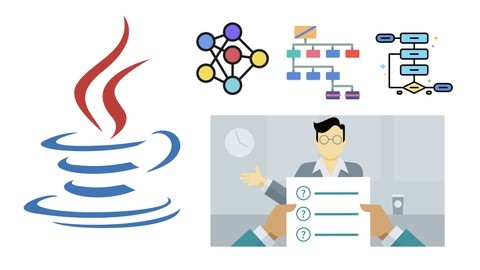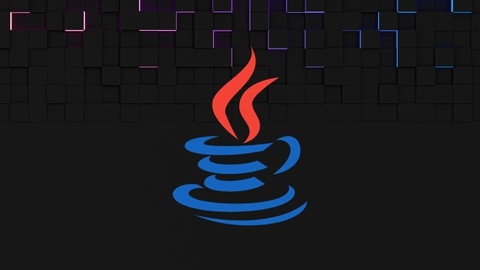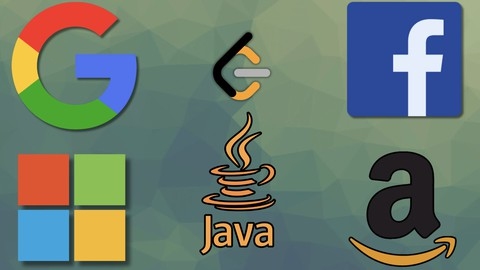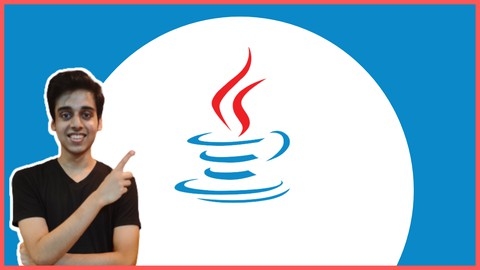Java Data Structures and Algorithms Masterclass
This course comprehensively covers everything from basic concepts to advanced topics, all through the lens of Java programming.
Let’s break down what this course offers and why it might be the right choice for you.
The journey begins with foundational knowledge, explaining the significance of data structures and algorithms.
You’ll quickly move on to understand Big O Notation, a critical tool for evaluating algorithm efficiency, covering various complexities like O(1), O(N), and O(N^2).
Arrays, both single and two-dimensional, are explored in depth.
You’ll learn to perform essential operations such as creation, insertion, access, and deletion.
Practical projects and coding exercises, including LeetCode challenges aimed at FAANG interview preparation, are integral parts of this section.
The course also dives into more sophisticated data structures like Linked Lists, Stacks, and Queues.
Through detailed examples, you’ll grasp the nuances of singly, doubly, and circular linked lists, and master stack and queue operations using arrays and linked lists.
Trees and binary trees receive thorough attention, with lessons on traversal, insertion, and deletion.
You’ll also study Binary Search Trees (BST), AVL Trees, and Binary Heaps, gaining insights into their operations and applications.
Graphs are another focus area, where you’ll learn about representation, BFS and DFS traversal algorithms, and tackle shortest path problems with Dijkstra’s and Bellman Ford algorithms.
Advanced topics like Minimum Spanning Trees, with Kruskal and Prim’s algorithms, are also covered.
For algorithmic strategies, the course offers sections on Recursion, Dynamic Programming, Divide and Conquer, and Greedy Algorithms.
You’ll solve complex problems using these techniques, sharpening your problem-solving skills.
Sorting and Searching Algorithms are comprehensively covered, including Bubble, Selection, Insertion, Merge, Quick, and Heap Sort, as well as Linear and Binary Search.
You’ll learn their implementations, efficiencies, and practical uses.
The course also teaches a structured approach to problem-solving and includes a section on Backtracking, where you tackle the N-Queens puzzle, among others.
With quizzes, coding exercises, and detailed solutions throughout, you’ll have ample practice opportunities.
Downloadable resources are available for further study.
Java Data Structures & Algorithms + LEETCODE Exercises
This course covers everything from the basics to advanced topics, making it ideal for beginners and those looking to refresh their skills.
The journey begins with an introduction to Java and strategies to maximize your learning.
Quickly moving forward, you’ll grasp Big O notation, learning to evaluate algorithm efficiency, understand worst-case scenarios, and recognize when to simplify your calculations.
This foundational knowledge is crucial for coding interviews and effective problem-solving.
The course extensively covers various data structures, including classes and pointers, linked lists (LL), doubly linked lists (DLL), stacks, queues, trees, hash tables, graphs, and heaps.
Each section offers detailed lectures on implementation in Java, operational insights, and performance analysis.
Quizzes and coding exercises are integrated throughout to solidify your understanding and application skills.
For linked lists, the course walks you through construction, manipulation, and advanced interview-level questions, such as detecting loops or finding the middle node.
Similarly, with doubly linked lists, you’ll learn operations like appending, removing, and checking for palindromes.
Stacks and queues are not just about implementation; you’ll also tackle real-world problems, like using stacks for balanced parentheses checks or simulating queues with two stacks.
The course doesn’t shy away from complex topics like trees and graphs, offering in-depth lessons on binary search trees (BST), tree traversal techniques (BFS and DFS), and graph operations.
Sorting algorithms, including bubble, selection, insertion, merge, and quick sorts, are demystified, teaching you the mechanics and appropriate use cases of each.
Dynamic programming is introduced with strategies like memoization and bottom-up approaches to solve problems efficiently, tackling classic challenges like the Fibonacci sequence.
LEETCODE exercises specific to each topic, from linked lists and trees to dynamic programming and sorting algorithms, are a significant part of the course.
These challenges test your knowledge and prepare you for technical interviews with problems ranging from array manipulation to validating BSTs and optimizing solutions.
Data Structures and Algorithms In Java ( DSA )
The course kicks off with an introduction to Data Structures and Algorithms, laying a solid foundation for understanding their importance in efficient problem-solving.
You’ll also learn about setting up a Source Code Repository, preparing you for the coding challenges ahead.
You’ll then move on to understanding how to measure the running time of algorithms and grasp the concept of Big O Notation.
This section is crucial for evaluating algorithm efficiency and includes lectures on finding Big O, as well as understanding tight and loose upper bounds.
The journey continues with an in-depth look at various data structures, starting with Linked Lists.
From basic operations like traversing and searching to more complex ones like reversing and sorting, the course covers it all.
It also delves into doubly linked lists, circular linked lists, and linked lists with header nodes.
Next, you’ll explore Stacks and Queues, learning their implementations using arrays and linked lists.
This section also covers specialized forms like circular queues and priority queues, and applications such as validating expressions and evaluating arithmetic expressions.
Recursion is demystified through practical examples, teaching you when and how to use recursion effectively, with examples like calculating factorials and solving the Tower of Hanoi.
The course then guides you through Trees, starting with Binary Trees and progressing to Binary Search Trees and Heaps.
You’ll learn about their types, implementations in Java, and operations like traversal, insertion, and deletion.
Sorting and Searching algorithms are covered extensively, from basic sorts like Bubble Sort and Selection Sort to advanced ones like Merge Sort, Quick Sort, and Radix Sort.
You’ll learn their Java implementations and understand their time complexities.
Finally, the course wraps up with Hashing, teaching you about direct addressing, hash functions, collision handling, and more.
Quizzes after each major section test your understanding, and practical examples throughout the course solidify your knowledge.
Advanced Data Structures and Algorithms in Java ( DSA )
Starting with an introduction to AVL trees, this course covers rotations, insertions, and deletions, supported by practical examples and a source code repository for hands-on learning.
You’ll also explore Threaded Binary Trees and Expression Trees, learning key operations like insertion and evaluation.
The course then advances to B trees, focusing on traversal, searching, and modification methods, essential for handling large datasets efficiently.
Graphs form a significant part of the curriculum, beginning with basic concepts and advancing to traversal algorithms such as Breadth First Search (BFS) and Depth First Search (DFS).
You’ll learn to solve problems like finding the shortest paths using Dijkstra’s algorithm and constructing minimum spanning trees with Prim’s and Kruskal’s algorithms.
Each section is carefully structured to build upon the last, ensuring a smooth progression through complex topics.
Practical Java implementations accompany theoretical concepts, enhancing your problem-solving skills and application knowledge.
By completing this course, you’ll gain a deep understanding of advanced data structures and algorithms, preparing you for challenging coding interviews and improving your software development capabilities.
Complete Core Java + DSA + Build Projects and more..
Starting with Java basics, you’ll quickly move on to practical exercises, learning about variables, data types, and control flow statements.
The course emphasizes hands-on learning, demonstrated through the development of a Banking Application project, where you apply concepts like deposits, withdrawals, and transaction histories.
As you progress, you’ll explore Object-Oriented Programming, covering classes, objects, inheritance, and more, with exercises to solidify your understanding.
The course also tackles arrays and strings, providing both theoretical knowledge and practical problem-solving experience.
A significant portion is dedicated to linked lists, including singly, doubly, and circular types, teaching you how to efficiently manage and manipulate data.
LEETCODE In Java: DSA Coding Interview Questions for MAANG
This course covers a broad spectrum of topics, including arrays, linked lists, dynamic programming, backtracking, trees, stacks, queues, and hash tables/dictionaries, all through the lens of Java programming.
Starting with array questions from Microsoft and Google, you’ll tackle problems like “Container with Most Water” and “Valid Mountain Array,” learning through various approaches from brute force to optimized solutions.
The course emphasizes understanding the problem, developing a solution strategy, and then moving on to pseudocode and code implementation.
Linked list questions from Apple and Amazon, such as “Merge Two Sorted Lists” and “Linked List Cycle,” will test your skills further, guiding you through each step of the solution process.
The course also dives into backtracking and dynamic programming with challenges like “Subsets” and “Coin Change,” preparing you for complex problem-solving scenarios.
With real-world problems from top tech companies, this course prepares you for what to expect in coding interviews, focusing on practical problem-solving skills and Java programming proficiency.
By the end, you’ll be well-equipped to face any coding challenge, making you a strong candidate for MAANG coding interviews.
Data Structures Algorithms in Java - SECRETS to Ace LeetCode
Starting from the ground up, this course introduces you to programming languages, guiding you through Java’s basics, including installation, input/output operations, debugging, and data types.
It ensures a solid foundation before moving on to more advanced topics.
The curriculum progresses to cover essential programming constructs like conditionals, loops, and functions, making complex concepts accessible.
You’ll tackle arrays, ArrayLists, strings, and dive into the intricacies of bitwise operators and number systems, preparing you for algorithmic challenges.
Key to this course are the real-world problem-solving sessions involving search and sort algorithms—linear, binary, bubble, selection, and more—each explained with clarity and applied through LeetCode challenges.
This hands-on approach extends to advanced topics such as recursion, backtracking, and object-oriented programming, where you’ll explore classes, objects, inheritance, and polymorphism.
Data structures get thorough attention, with lectures on linked lists, stacks, queues, binary trees, and binary search trees, complemented by practical LeetCode problems to solidify your understanding.
The course also includes a deep dive into the Java Collections Framework, equipping you with the skills to handle collections efficiently.
Data Structure and Algorithm for Interview preparation[Java]
It starts with the fundamentals of Data Structure and Algorithms (DSA), teaching you about time and space complexity to optimize your code efficiently.
You’ll quickly move on to practical applications, learning how to manipulate arrays and strings, and understanding the dynamic nature of lists through ArrayLists and LinkedLists, complete with examples like adding “Zara” and “Mahnaz” to your lists.
The course also covers Sets and Maps, explaining the importance of uniqueness in Sets and introducing you to key-value pairs in Maps.
Through hands-on examples, you’ll learn to solve common problems, such as counting element frequencies.
Stacks and Queues are demystified next, setting the stage for tackling real-world problems from platforms like LeetCode.
This includes finding duplicate elements in arrays and employing the two-pointer approach for complex puzzles.
Advanced topics aren’t left out.
You’ll explore Depth First Search in 2D arrays, Dynamic Programming, and Trees, learning techniques like flood fill and unique tree traversals (e.g., Zig Zag, Right View).
This course emphasizes practical, hands-on learning, ensuring you solve actual problems and understand the reasoning behind each solution.
Data Structures and Algorithms: Deep Dive Using Java
Led by Tim Buchalka, the course starts with an introduction to Java setup for all operating systems, ensuring you’re ready to tackle the lessons ahead.
You’ll quickly move into understanding the basics of data structures and algorithms, including the pivotal Big-O Notation for assessing algorithm efficiency.
The course thoroughly covers sorting algorithms, from Bubble Sort to Quick Sort, with practical implementation videos and challenges to test your knowledge.
It doesn’t stop there; you’ll explore Lists, Stacks, Queues, and Hashtables, learning both the theory behind these structures and how to implement them in Java.
Search algorithms, including Linear and Binary Search, are explained in detail, alongside iterative and recursive implementations.
A significant focus is placed on Trees and Heaps, where you’ll learn operations such as insertion, traversal, and deletion, and even tackle sorting with Heapsort.
Challenges throughout the course push you to apply what you’ve learned, with solutions provided to guide your understanding.
Wrapping up, the course touches on Sets in the JDK and offers a comprehensive review of all topics covered.
Extra resources, including source codes and bonus lectures, are available to enrich your learning experience further.
This course stands out for its blend of theoretical knowledge and practical application, making complex concepts accessible and engaging.
Practical Data Structures & Algorithms in Java + HW
Starting with an introduction to Object-Oriented Programming (OOP), it lays a solid foundation by teaching you how to use classes for creating abstract types and structures.
This preparation is crucial for understanding the data structures covered later in the course.
The curriculum then moves into essential data structures, where you’ll learn about stacks, queues, and linked lists through practical Java exercises and homework.
These sections are designed to build your coding skills step by step.
A significant part of the course focuses on searching and sorting algorithms, including linear and binary searches, as well as selection, insertion, merge, and quick sorts.
Each topic comes with coding assignments and solution videos, encouraging active learning.
Advanced topics such as binary search trees, heaps, and hash tables are also covered.
You’ll see how these structures are implemented in Java and explore their real-world applications, particularly in databases and data storage technologies.
Graphs, a critical data structure for modeling real-life scenarios, are explained with practical Java sessions.
This ensures you’re ready to tackle graph-related problems in technical interviews.
Throughout the course, you’ll benefit from dedicated TA support and access to source code for all lectures, enabling you to practice effectively.








![Data Structure and Algorithm for Interview preparation[Java]](/img/best-java-dsa-courses-udemy/4182074_DataStructureandAlgorithmforInterviewpreparationJava.jpg)

